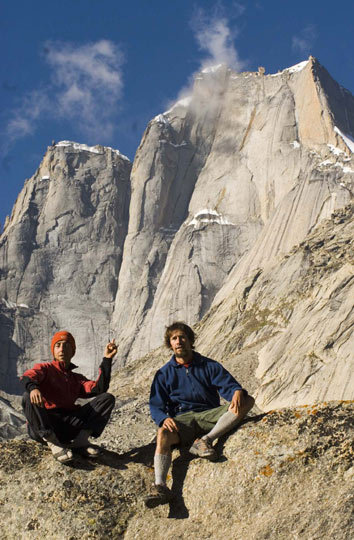
Dash and Copp in front of the previously unclimbed Shaffat Fortress in India’s Kashmir region. Their line, the Colorado Route (VI 5.11 M6 A1, 21 pitches, 1100m) follows the dark corner system in the center of the face past the two snow bands to the summit. [Photo] Jonathon Copp
Jonny Copp and Micah Dash, both of Colorado, made the first ascent of an unclimbed 1100-meter wall called Shaffat Fortress in India’s Zanskar range from August 8-11. Their climb, Colorado Route (VI 5.11 M6 A1, 21 pitches, 1100m) is representative of the enormous attention given to the spires of northern India and Pakistan from strong alpine-style teams in recent years.
A few troubles set them back before the climbing began: a bag was stolen in Delhi, leaving a mere two ropes (the bag was miraculously recovered later), and a seven-member Italian team, replete with hundreds of pounds of rope and gear, issued Copp and Dash a serious warning that they would go to jail if they climbed without a permit.
But on August 8 the pair found easy access across the bergshrund and good climbing in a corner system, until bad water ice encrusted the dihedral. Forced to carefully time pitches in order to avoid any direct sunlight, progress slowed to a crawl, and they barely reached a “heinous” bivy site halfway up the face before dark, having resorted to a combination of rock shoes, tools and crampons to overcome difficult and scary mixed sections up to M6.
They spent the night swapping use of their single sleeping bag on a small snow cone. Copp and Dash forced two pitches to a better ledge the next morning, but storms kept them pinned down for the rest of the day.
The third day on the wall yielded better weather and one of the psychological cruxes of the route. “The Shaft,” as Copp called it in his initial email report, was “a feature of concern. [Dash] was 150 feet above me when he let out a scream of true terror. His hands and feet were frozen by melt-water and he was twenty-five feet run-out in a rotten offwidth crack.” That single pitch took the pair three hours to climb. Copp continued: “Can you grade pitches like that?”
Copp and Dash reached the top, gaining incredible views of Pakistan’s Karakoram, on August 11. They descended their route the same day; at the bottom they found time to befriend the Italians for a celebration, replete with cheese and rum. According to Copp, the pair also saw prints of the extremely rare snow leopard and stumbled upon ancient pottery in a desolate cave, which “combined to make the trip quite memorable.”
The Colorado Route marks another technically challenging rock climb, done in alpine style, on a remote peak. Similar climbs such as Cordes and Wharton’s ascent of the Azeem Ridge, Kopold and Cmarik’s blitz up Uli Biaho and the Dash-Decaria push up Cat’s Ear Spire give a glimpse of the future, when highly difficult and technical rock routes will frequently stand alongside more traditional alpine climbs in the greater ranges. Most of these routes are nearly all rock and require little ice gear; the strongest teams are freeing these big walls with minimal equipment, in astounding times. “It’s more fun and less work to climb fast,” Copp said, “but you have to train for it and be ready to suffer and fail, too.”